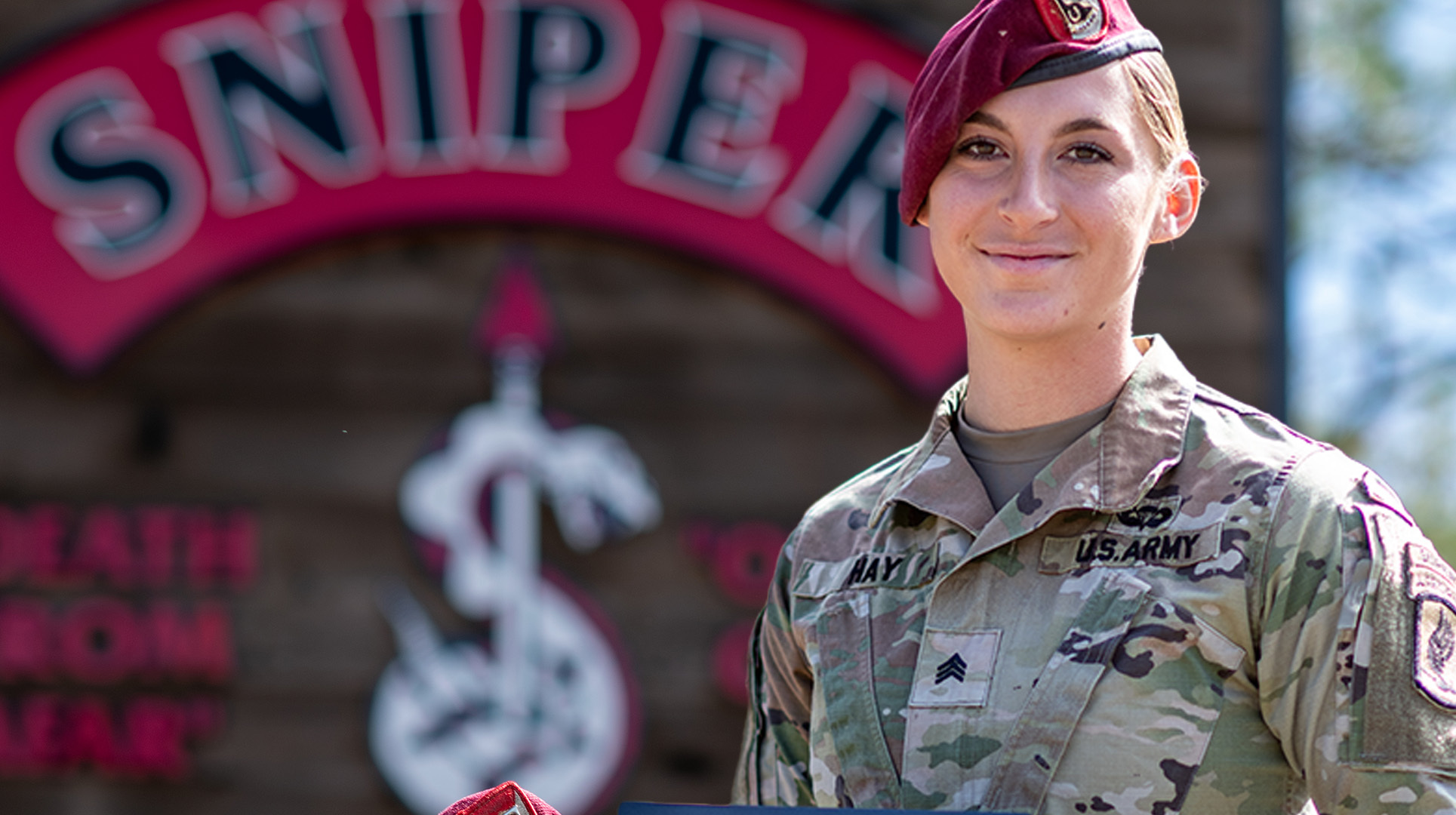

An NCO whose high school friends called her “sniper” made good on that nickname last month when she became the first woman on active duty to graduate from the Army’s sniper course.
Sgt. Maciel Hay, a cavalry scout with the 173rd Airborne Brigade in Vicenza, Italy, completed the 5-week course at Fort Moore, Georgia last month. She is currently deployed with the brigade in Germany as part of the Army’s rapid response force to Europe, Africa and the Middle East.
“My nickname growing up was ‘Sniper,’” Hay said in an Army release. “I grew up shooting, mostly rifles and handguns, on my family’s ranches in Rocklin, California and Medford, Oregon. But the nickname came from the fact that I could find things really fast, similar to how a sniper does target detection,” she said.
According to the Army, Hay is the first woman on active duty to complete the course and at least the second woman. In November 2021, a Montana National Guard soldier became the first woman to complete the U.S. Army Sniper Course at Fort Moore, then Fort Benning. In the Air Force, then-Senior Airman Jennifer Weitekamp was the first woman to complete the Air National Guard’s Counter Sniper School in 2001.
Hay said her uncle Cy taught her the basics of shooting, but it wasn’t until she went to nearby Sierra College that she set her sights on becoming a sniper. A close friend told Hay she’d never make it in the Army or become a sniper.
“Needless to say, that person is no longer part of my life. But now that I look back at it, I really do appreciate the motivation,” she said in a release.
To prepare for sniper school, Hay had to make her own ghillie suit, the full-body camouflage suit that snipers rely on to stay invisible while stalking a target. Snipers often spend dozens of hours constructing a suit, attaching grass and leaves that match the specific vegetation of a region.
Building her suit was a group effort, Hay said, that took multiple people and many hours of sewing, she said.
Students in the Army sniper course are taught to make ghillie suits using a base layer and adding artificial or natural elements to “break up the silhouette of our human signature,” said Sfc. Timothy Moore, marksmanship team chief. “No two ghillie suits are going to be the same.”
Subscribe to Task & Purpose Today. Get the latest military news and culture in your inbox daily.
Sniper school is widely viewed as one of the toughest courses in the Army, and is open only to soldiers who are already in the infantry, Special Forces or are Cavalry Scouts like Hay. Soldiers must also “shoot expert” on their Army marksmanship test, hitting at least 36 out of 40 targets.
The 29-day course has a notorious attrition rate. According to a 2017 Army report that followed a class of 46 students through the course, only 4 graduated.
In the last year, the course went from seven weeks to five weeks after officials integrated some classes into lessons taught throughout the course.
Major skills of the school include stalking and concealment, observation and intelligence gathering, survival skills, land navigation, and urban sniper operations. Through the course, students study advanced camouflage techniques with the use of hides, terrain utilization, concealed movement, range estimation and determination, target detection and elimination of target indicators.
According to Moore, there’s not one part of the course that every student struggles. Much depends, he said, on the training that soldiers receive before they get there.
“Being a sniper is a very particular thing and the training we do has to be very hands-on, very methodical, very thorough,” Moore said. When students do struggle during the course, Moore said, usually their nerves get the best of them.
“Being a sniper, you have to be very calm, collected and very level headed,” he said.
During the marksmanship part of training, students train in proper body positioning, application of the direct fire engagement process, use of a ballistic calculator, as well as target practice for known and unknown distances, stationary and moving targets, and limited visibility conditions.
Hay said she found the rapid target engagement and intelligence reporting to be the toughest parts of the course. She also said they had to engage long distance targets while sitting on rucksacks which proved difficult.
Her next duty station will be in Anchorage, Alaska, with the 40th Cavalry Regiment in the 11th Airborne Division. Hay’s next goal is to become a jumpmaster, with many people encouraging her to eventually go to Ranger school.
The latest on Task & Purpose
- Marine Infantry veteran says enlisted shouldn’t become officers — mayhem ensues
- Father loses 80 pounds, joins Air Force alongside his 2 sons
- Opinion: Veterans won’t help the recruiting crisis until our issues are addressed
- Navy fires head of Amphibious Squadron 5 for ‘loss of confidence’
- How much do CIA case officers get paid? A look at life as a spook